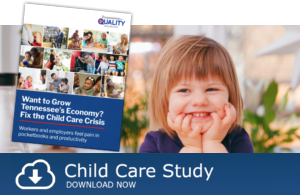Want to Grow Tennessee’s Economy? Fix the Child Care Crisis
If you’re a Tennessean, the Child Care Crisis impacts you. We have the numbers to prove it.
Our 2019 report, “Want to Grow Tennessee’s Economy? Fix the Child Care Crisis,” delivers unprecedented insight into the adverse economic impacts of Tennessee’s child care system dysfunction. The consequences: $1.34 billion annually in lost earnings and revenue.
Tennessee parents who encounter child care problems are hit hard – losing an estimated $850 million in earnings each year. An overwhelming 98 percent of Tennessee parents of children under age 5 said that inadequate child care services hurt their work productivity or limited career opportunities. Specifically: 39 percent turned down a new job offer or promotion, 35 percent had pay or hours reduced or changed employment status to part-time, 33 percent turned down education or training, and 32 percent had to quit a job, or were fired or demoted.
Access, affordability and quality are the primary factors that drag down the system. Two-thirds of parents said they have trouble accessing care at all, exacerbated by the fact that 48 percent of Tennesseans live in a child care “desert” – an area that has three times as many children as licensed child care slots. Two-thirds of parents say affordability of care is a big challenge. The cost of two children in center-based care is nearly $16,000 annually – 21 percent of the median income of a Tennessee married family and 60.4 percent of families living in poverty. Another 50 percent cite finding suitable quality as an issue.
Read the Reports
Regional Reports
Sponsors
Workers and employers feel pain in pocketbooks and productivity
Acknowledgements
About this Report
This report was produced by Tennesseans for Quality Early Education (TQEE), with support from Dr. Clive Belfield, Ph.D. and Zogby Analytics.
Tennesseans for Quality Early Education is a statewide, bipartisan nonprofit that unites business, elected leaders, law enforcement, faith, education and civic organizations and people in communities across Tennessee to make high-quality early learning, birth through third grade, an urgent policy priority.
Dr. Clive Belfield, Ph.D. is a Professor of Economics at the City University of New York and an Economist with the Center for Benefit-Cost Studies in Education, Teachers College, Columbia University. He was commissioned by TQEE to produce The Economic Consequences of Insufficient Child Care on Working Families across Tennessee on which this report is based.
Zogby Analytics was commissioned by TQEE to conduct a new survey of Tennessee parents with a child under age 5. The survey is large-scale, new (administered June 8, 2019 through July 9, 2019), and has a sampling frame that matches to Tennessee household demographics (race, age, family size), labor market conditions in Tennessee (earnings, sector of work), and regional populations. Based on a confidence interval of 95%, the margin of error for the 2,330 surveys is +/- 2.0 percentage points.
Sponsors
- Ayers Foundation
- Ballad Health
- Blue Cross Blue Shield of Tennessee
- Bristol Chamber of Commerce
- Chattanooga Area Chamber of Commerce
- Decatur County Chamber of Commerce
- East Tennessee Children’s Hospital
- First Tennessee Bank
- First Foundation
- Greater Memphis Chamber of Commerce
- Hyde Family Foundation
- Johnson City Chamber of Commerce
- Kingsport Chamber of Commerce
- Knoxville Chamber of Commerce
- Memphis Tomorrow
- Nashville Area Chamber of Commerce
- Perry County Chamber of Commerce
- PNC Bank
- Suntrust Bank
- Tennessee Business Roundtable
- Tennessee Chamber of Commerce
- The Urban Child Institute
This report builds on a similar national report by ReadyNation – Council for a Strong America issued earlier this year. We deeply appreciate the generous collaboration of the ReadyNation organization, and the Pritzker Children’s Initiative which funded their report.
Executive Summary
Talk to most Tennessee parents of children under age 5, and you’re likely to hear how difficult it is to find child care that’s accessible, affordable, and of sufficient quality to support their child’s school readiness.
Talk to their employers, and you’re likely to hear about workforce recruitment and productivity issues that will only worsen as the state’s child care crisis continues.
The top-line findings of a new study that examined adverse economic impacts of inadequate child care on Tennessee parents, businesses, and taxpayers reveal the consequences: $1.34 billion annually in lost earnings and revenue.
The study, conducted by Tennesseans for Quality Early Education (TQEE), surveyed Tennessee parents of children under age 5 and modeled how the state’s economy is affected by child care. [1] An overwhelming 98% said inadequate child care hurt their work productivity and/or career opportunities. Productivity challenges affect both the employer and employee.
What’s causing the problem? When parents were asked about the most significant child care challenges, half cited difficulty finding child care that is high quality; 63% cited affordability; and 65% cited access (such as finding care that has open slots or accommodates a work schedule
outside M-F daytime hours).
Most significant challenge finding suitable child care?
Child care problems are not unique to Tennessee. National business organizations such as the U.S. Chamber of Commerce,2 The Conference Board’s Committee for Economic Development,3 and ReadyNation4 have all issued recent reports highlighting the urgent need to address the nation’s child care crisis.
The evidence is clear and the stakes are high. It’s time for a child care overhaul in Tennessee. Our intention is for this report to be a springboard for collaborative problem-solving by state policymakers and the private sector to optimize child care for affordability, quality, and access.
Most parents of young children are in the workforce and need child care
In Tennessee, more than 300,000 children (66%)under the age of 6 have all available parents in the workforce.5 More than a third of surveyed families rely on formal center-based care, Head Start or school-based PreK. Others cobble together multiple arrangements and rely on informal and often unlicensed care, with 42% relying on family members for at least part of the time.
Parents need child care so they can go to work, earn a living for their families, and build successful careers. To be productive at work, they also need to know that the care provides a safe, nurturing environment that supports their child’s development and early learning.
The current child care system does not meet the needs of families or employers
Several interrelated challenges render Tennessee’s child care system lacking.
Access: Two-thirds of Tennessee parents reported problems accessing suitable child care, meaning care that is available outside Monday-Friday daytime hours, can accommodate changing shifts, has open slots, is in a convenient location, or offers backup/sick child care. In fact, 48% percent of Tennesseans live in a child care desert — a census tract where there are more than 3 times as many children as licensed child care slots.6 Exacerbating the problem is the fact that the number of child care providers in Tennessee has declined by 11.4% since 2010 — from 14,888 to 13,185 market-based child care providers.[7]
Affordability: Two-thirds of Tennessee parents reported affordability as a significant challenge for securing child care to support their employment. Fewer than 1 in 7 reported receiving financial support for child care from either their employer or from the Tennessee Child Care Payment Assistance Plan. The cost of center-based care for an infant in Tennessee is $8,524 per year, nearly as much as public college tuition at $9,789. Add a 4-year old and the cost rises to $15,814. This is 20.9% of the median income of a married family and 60.4% if that family
lives in poverty.[8] This high cost makes child care unaffordable for many of Tennessee’s hardworking families.
Quality: Half of Tennessee parents reported finding quality care as a major problem impacting their employment. Currently, of the 13,185 child care providers in Tennessee, only 4,257 are licensed by TDHS or certified by Tennessee Department of Education.9 Even when providers are licensed, participation in Tennessee’s Star Quality Rating System is optional. Furthermore, the system’s highest rating of 3 stars does not meet key quality standards included for national accreditation by the National Association for the Education of Young Children (NAEYC), a widely acknowledged gold standard for high quality practices in child development and early learning. Only 65 of the 4,257 licensed or certified child care programs in Tennessee are accredited
by NAEYC. [10] Only 5 family child care home-based providers are accredited by NAEYC’s sister organization: the National Association for Family Child Care (NAFCC). [11]
How inadequate child care adversely impacts parents, employers, and taxpayers
When families do not have the child care they need, parents’ work productivity falls, resulting in costs to parents, their employers, and ultimately, taxpayers. The survey results provide a window into how the economic impacts occur.
Parents. Parents reported that child care problems affected their time and productivity at work and diminished their career opportunities. The primary consequence is reduced earnings; and with less training and less experience there are lost future earnings as well. The result: Tennessee’s working parents and their families lose a whopping $850 million per year.
Employers. For employers, insufficient child care results in reduced revenue, potentially significant increases in hiring and retention
costs, and lost profits. A workforce with lower productivity and shorter tenure has major economic consequences: if an employer’s workforce keeps changing, worker morale may fall, product quality may diminish, and clients may be lost. As well, there are immediate direct costs associated with recruitment, hiring, and training as the workforce turns over. There are also future losses and costs when workers are not well-trained and have too little experience.
The lost revenue to Tennessee businesses due to child care problems for parents of young children is $270 million per year.
Taxpayers. The economic impact of the child care crisis on parents and employers results in lower earnings, lower consumption of taxable
goods, lower profit margins and ultimately, lower tax revenues. As a result, Tennessee taxpayers lose $220 million per year.
As a result of child care problems over the past three months have you:
As a result of child care problems have you ever:
As a result of child care problems have you ever:
The time is right for Tennessee’s leaders to solve our state’s child care crisis.
The practical and economic consequences of inadequate child care are enormous. The economic impact of $1.34 billion annually in this report is just the tip of the iceberg.
A massive body of research has documented impressive returns on investment for high quality early education programs of $7-13 for every $1 invested from longer-term positive effects on employment, health, criminal activity, and dependence on government assistance. [12] Improving quality, affordability, and access could have a dramatic impact on Tennessee’s workforce of today, our workforce of tomorrow and our future economic prosperity as a state.
There’s a ‘triple bottom line’ for high-quality child care. Not only is it a major factor for workforce and business productivity; it also supports economic mobility for families, while helping close the skills gap so young children are prepared for success in school.
The good news is that Tennessee has significant unspent resources — nearly $1 billion over the past 5 years — which, if redirected more effectively, could go a long way towards supporting innovative new solutions. The federal government supports families’ need for child care with funding to states (e.g. the Child Care and Development Block Grant, Temporary Assistance to Needy Families) and through the tax code. Much of this and other resources have been underutilized in Tennessee for many years, and could be deployed more strategically to address quality, affordability, and access.[13] Tennessee is in a uniquely strong position with existing money and other resources available to start fixing the child care crisis.
The solution will require ingenuity and collaboration between the public and private sectors. Challenges to be addressed include: the high costs of operating a quality child care business, the skills gap in the child care workforce, and data management at all levels of the child care system, from state administration to classrooms.
While government leadership is crucial, businesses have a role to play as well, deploying creative solutions from on-site child care to helping employees pay for child care with pre-tax dollars. In fact it is worth noting that more than 1 in 3 Tennessee parents surveyed said they are dissatisfied with their employer’s support for their child care needs, suggesting that those offering greater support may have a competitive advantage.
Fixing the problem begins with making it a priority. The solutions will come from well-organized and collaborative problem-solving by state policymakers and the private sector. The time to act is now.
Endnotes
- For details on the survey and economic analyses, see the accompanying technical report: The Economic Consequences of Insufficient Child Care on Working Families across Tennessee (2019) at http://tqee.org/app/uploads/2020/02/TQEE_-Belfield-Report_FINAL.pdf
- U.S. Chamber of Commerce Foundation (2017). Workforce of Today, Workforce of Tomorrow. Retrieved from: https://www.uschamberfoundation.org/reports/workforce-today-workforce-tomorrow.
- Committee for Economic Development of the Conference Board (2019). Child Care in State Economies: 2019 Update. Retrieved from. https://www.ced.org/assets/reports/childcareimpact/181104%20CCSE%20Report%20Jan30.pdf.
- Council for a Strong America (2019). Want to Grow the Economy? Fix the Child Care Crisis. Retrieved from: https://www.strongnation.org/articles/780-want-to-grow-the-economy-fix-the-child-care-crisis.
- U.S. Census Bureau, American Community Survey, 2013-2017 American Community Survey 5-Year Estimates;Retrieved via American FactFinder at https://factfinder.census.gov/faces/tableservices/jsf/pages/productview.xhtml pid=ACS_17_5YR_CP03&prodType=table.
- Center for American Progress (2018). America’s Child Care Deserts in 2018. Retrieved from: https://childcaredeserts.org/index.html?state=TN.
- Committee for Economic Development of the Conference Board (2019). Child Care in State Economies: 2019 update. Tennessee: Fact Sheets. Retrieved from: https://www.ced.org/assets/reports/childcareimpact/fact_sheets/revised/Tennessee%20Fact%20Sheet%201312019.pdf.
- Child Care Aware of America (2018). The U.S. and the High Cost of Child Care. Interactive Map. Retrieved from: https://usa.childcareaware.org/advocacy-public-policy/resources/research/costofcare/.
- Tennessee Department of Human Services: Child Care Providers Map. Retrieved from: https://www.tn.gov/humanservices/for-families/child-care-services/find-child-care.html
- National Association for the Education of Young Children: NAEYC Accredited Programs. Retrieved from: https://families.naeyc.org/search_programs/results/0/TN/0/10/0/0/0/us/0.
- National Association for Family Child Care: Accredited Provider Search. Retrieved from: https://www.nafcc.org/Accredited-ProviderSearch-Function.
- Heckman Economics of Human Potential: 13% ROI for Birth-to-Five Programs. Retrieved from: https://heckmanequation.org/resource/13-roi-toolbox/.
- Tennesseans for Quality Early Education (2019). Tennessee Resources for Fixing the Child Care Crisis. Blog, at TQEE.org.


























